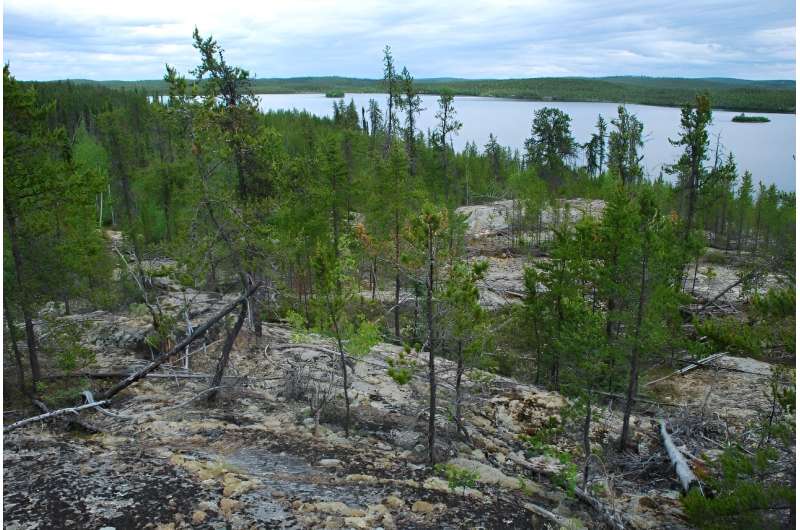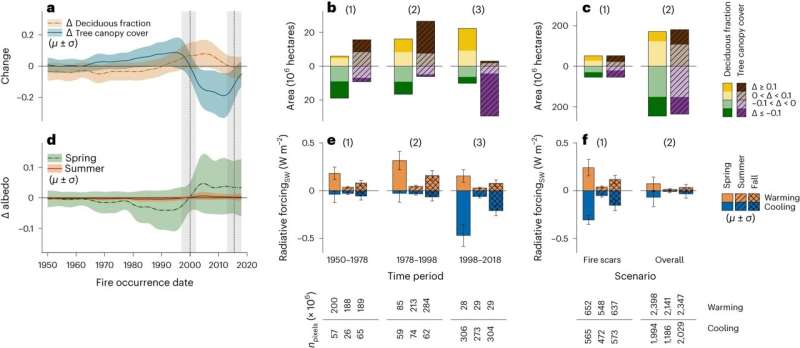This article has been reviewed according to Science X's editorial process and policies. Editors have highlighted the following attributes while ensuring the content's credibility:
fact-checked
peer-reviewed publication
trusted source
proofread
New study shows surprising effects of fire in North America's boreal forests

A new study, using a first-of-its-kind approach to analyze satellite imagery from boreal forests over the last three decades, has found that fire may be changing the face of the region in a way researchers did not previously anticipate.
Historically, fires in North American boreal forests have led to coniferous trees being supplanted by deciduous trees, which are faster growing, take up more carbon and reflect more light, leading to cooling of the climate and decreased likelihood of fire.
The study, led by Northern Arizona University and published today in Nature Climate Change, found that surprisingly, while forests do become more deciduous, they don't stay that way; a few decades later, the same forests gradually start to shift back toward coniferous trees.
Researchers also found that the abrupt loss of coniferous forests caused by wildfire was offset by the gradual increase in coniferous forests in areas that had not recently burned, so there was no overall shift toward deciduous cover.
"We confirmed that fires clearly shift forests from conifer to deciduous cover, but when we look at those changes over many decades, we find deciduous trees begin to be replaced again by conifer trees three to four decades following fire," said Scott Goetz, Regents' professor in the School of Informatics, Computing, and Cyber Systems (SICCS) at Northern Arizona University and study co-author. "There are tremendous dynamics taking place, but when we tally those all up, the net feedbacks to climate were fairly small."
"This was somewhat surprising because several recent studies suggested there were shifts toward deciduous forests at local to regional scales," said Logan Berner, assistant research professor in SICCS and study co-author. "While our study indicates there have not been wholesale shifts in forest composition during recent decades, we anticipate that continued climate warming and increased wildfire activity could lead to pronounced changes in forest composition over the coming decades."

The researchers note this may not be permanent; recent decades have seen an uptick in fire disturbance in these forests, so in the future, the return to coniferous cover may take longer than it has in the past. As the climate continues to get warmer and drier, that also will affect how forests burn and how they recover.
"As we think about fire management approaches, including efforts to reduce carbon emissions and mitigate fire risk to local communities and infrastructure, this study provides a critical foundation for future research," said Brendan Rogers, associate scientist at Woodwell Climate Research Center and study co-author.
"Especially after a summer of record-breaking fires in Canada, understanding how the composition of these forests will shift and respond to fire over time is crucial to informing best management practices and protecting people and the planet."
The team conducted the research as part of NASA's Arctic Boreal Vulnerability Experiment (ABoVE), of which Goetz is the Science Team Lead.
As part of their project within ABoVE, they used high-resolution satellite imagery of the boreal forests across Alaska and Canada captured by the Landsat series of satellites to quantify changes in forest composition, both in areas that have burned and those that haven't. They also quantified the effects of changing forests using satellite measurements of surface reflectivity and calculated the feedback effects on climate.
More information: Massey, R., et al, Forest composition change and biophysical climate feedbacks across boreal North America, Nature Climate Change (2023). DOI: 10.1038/s41558-023-01851-w. www.nature.com/articles/s41558-023-01851-w
Journal information: Nature Climate Change
Provided by Northern Arizona University





















